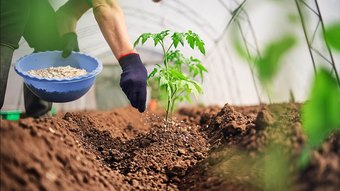Hydrangeas, known for their vibrant blooms and lush foliage, are a popular choice among gardeners across the United States. To ensure these stunning flowers reach their full potential, proper fertilization is crucial. This article can help you understand the right type of fertilizer and the best practices for application.

Understanding Hydrangea Nutrient Needs
Hydrangeas require a balanced mix of nutrients to thrive. The primary nutrients essential for hydrangea growth include nitrogen (N), phosphorus (P), and potassium (K). Nitrogen promotes leafy growth, phosphorus encourages root and bloom development, and potassium enhances overall plant health and resistance to diseases.
-
Nitrogen (N): Promotes lush, green foliage.
-
Phosphorus (P): Essential for strong root development and flower production.
-
Potassium (K): Supports overall plant vigor and disease resistance.
When choosing a fertilizer for your hydrangeas, it's important to consider the specific nutrient balance your plants need. Fertilizers are labeled with three numbers indicating the ratio of nitrogen, phosphorus, and potassium (N-P-K). For hydrangeas, a balanced or slightly higher phosphorus formula is ideal, such as 10-10-10 or 10-20-10.
Types of Fertilizers:
-
Granular Fertilizers: Slow-release and easy to apply, providing nutrients over an extended period.
-
Liquid Fertilizers: Fast-acting and quickly absorbed by the plants, ideal for immediate nutrient boosts.
-
Organic Fertilizers: Environmentally friendly options like compost, manure, and bone meal that improve soil health and provide slow-release nutrients.
Recommended Fertilizers for Hydrangeas
-
Espoma Holly-Tone: This organic fertilizer is well-suited for hydrangeas, especially those that prefer acidic soil. It contains a balanced N-P-K ratio and essential micronutrients.
-
Miracle-Gro Water Soluble Bloom Booster: Known for promoting prolific blooms, this liquid fertilizer has a higher phosphorus content (15-30-15) and is ideal for hydrangeas.
-
Jobe’s Organics All Purpose Fertilizer: This granular fertilizer provides a balanced nutrient mix (4-4-4) and is enriched with beneficial microbes to enhance soil health.
-
Dr. Earth Acid Lovers Organic Fertilizer: Perfect for hydrangeas that thrive in acidic conditions, this fertilizer offers a balanced N-P-K ratio and added calcium for strong cell walls.
Application Tips for Optimal Results
Applying fertilizer correctly is crucial for the health and productivity of your hydrangeas. Here are some tips to ensure you get the best results:
-
Timing: Fertilize hydrangeas in early spring when new growth begins and again in mid-summer to support continuous blooming.
-
Quantity: Follow the instructions on the fertilizer package. Over-fertilizing can lead to excessive leafy growth at the expense of flowers.
-
Method: For granular fertilizers, sprinkle the recommended amount around the base of the plant and gently work it into the soil. For liquid fertilizers, mix according to the instructions and apply directly to the soil or foliage.
-
Watering: After applying fertilizer, water the plants thoroughly to help the nutrients penetrate the soil and reach the roots.
Adjusting Soil pH for Bloom Color
One unique aspect of hydrangeas is their ability to change bloom color based on soil pH. Adjusting the pH can result in blue or pink flowers, adding an extra layer of customization to your garden.
-
Blue Blooms: For blue flowers, the soil needs to be more acidic (pH 5.2-5.5). Aluminum sulfate can be added to the soil to lower the pH.
-
Pink Blooms: For pink flowers, the soil should be more alkaline (pH 6.0-6.2). Adding lime to the soil can increase the pH.
Detailed Guide on Organic vs. Synthetic Fertilizers
When selecting fertilizers for hydrangeas, gardeners often face a choice between organic and synthetic options. Both types have their advantages and disadvantages, making it essential to understand their differences to make an informed decision.
Organic Fertilizers
-
Environmental Impact: Organic fertilizers are made from natural materials such as compost, manure, and bone meal. They are environmentally friendly and improve soil health by increasing organic matter and microbial activity.
-
Slow Release: Nutrients in organic fertilizers are released slowly, reducing the risk of over-fertilization and nutrient runoff. This gradual release ensures a steady supply of nutrients over time.
-
Soil Health: Organic fertilizers enhance soil structure, water retention, and root development, promoting long-term plant health.
-
Nutrient Content: Organic fertilizers often have lower nutrient concentrations compared to synthetic ones, requiring larger quantities to achieve the desired effect.
-
Cost: Organic options can be more expensive and less readily available than synthetic fertilizers.
Synthetic Fertilizers
-
Nutrient Precision: Synthetic fertilizers are formulated with specific nutrient ratios, allowing for precise control over the nutrients provided to plants. This can lead to faster growth and more prolific blooms.
-
Availability: They are widely available, easy to use, and often less expensive than organic alternatives.
-
Environmental Impact: Synthetic fertilizers can contribute to nutrient runoff, pollution, and soil degradation over time. They do not improve soil structure or health.
-
Fast Release: Nutrients are released quickly, which can lead to over-fertilization, burning of plants, and environmental harm if not applied correctly.
Seasonal Care Tips for Hydrangeas
To maintain healthy hydrangeas year-round, it's essential to follow seasonal care practices. Each season presents unique challenges and opportunities for hydrangea care.
-
Spring: Apply a balanced or high-phosphorus fertilizer in early spring to support new growth and bloom development. Prune dead or damaged stems to encourage healthy new growth. For varieties that bloom on old wood, be cautious not to remove buds that will produce flowers. Ensure consistent moisture as new growth begins, but avoid waterlogging the soil.
-
Summer: Apply a second round of fertilizer in mid-summer to support continuous blooming. Use a water-soluble bloom booster for quick nutrient absorption. Hydrangeas need regular watering during hot summer months. Water deeply and consistently to keep the soil moist. Apply mulch around the base of the plants to retain moisture, suppress weeds, and regulate soil temperature.
-
Fall: Avoid heavy pruning in the fall, as this can remove buds that will bloom the following year. Lightly trim dead or diseased branches. Fall is a good time to adjust soil pH for desired bloom colors in the next season. Add aluminum sulfate for blue blooms or lime for pink blooms. Begin preparing hydrangeas for winter by reducing watering and avoiding late-season fertilization, which can promote tender growth susceptible to frost damage.
-
Winter: In colder regions, protect hydrangeas from harsh winter conditions by mulching heavily around the base and covering plants with burlap or protective fabric. Ensure the soil remains slightly moist but not waterlogged. Overly dry soil can damage roots during winter dormancy.
Conclusion
Choosing the right fertilizer and following proper care practices can significantly enhance the beauty and health of your hydrangeas. By understanding their nutrient needs, selecting the appropriate fertilizer, and maintaining optimal growing conditions, you can enjoy a stunning display of blooms throughout the summer. With these tips, your hydrangeas will thrive, adding vibrant color and lush foliage to your garden.



